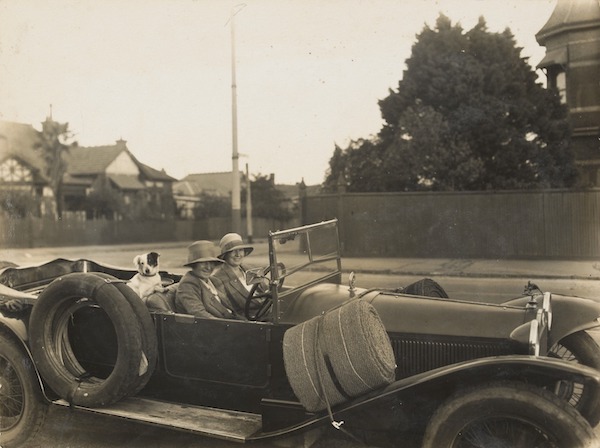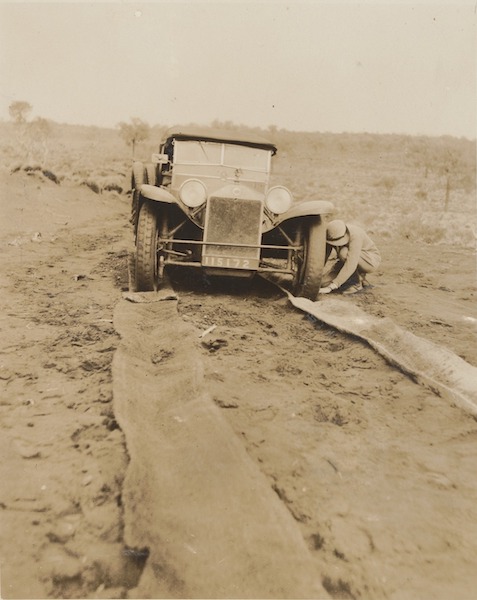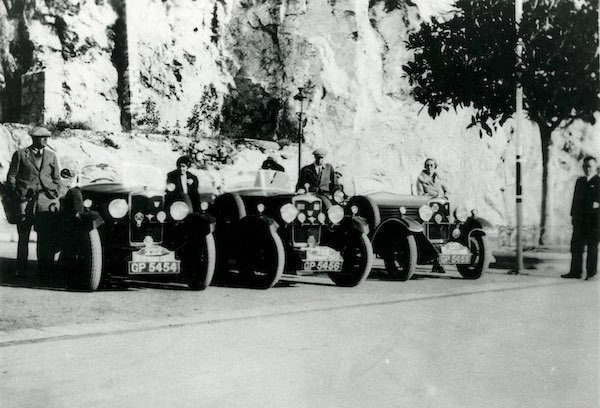Written by Jessica Buckton, RAHS Volunteer
To celebrate Women’s History Month in 2023, the Royal Australian Historical Society will continue our work from previous years to highlight Australian women that have contributed to our history in various and meaningful ways. You can browse the women featured on our webpage, Women’s History Month.

Jean Robertson and Kathleen Howell seated in Lancia Lambda with Barney the dog, car parked in suburban street [State Library of Victoria].
Jean and Kathleen attended the Clyde School in Melbourne and became fast friends.[3] They were both well off and had been interested in motoring for much of their lives. Jean was from a wealthy pastoral family and had been gifted an Italian Lancia Lambda by her father, which both women used to take trips on.[4] They were well acquainted with car mechanics and with the outdoors. Jean gained a motor maintenance qualification at Alice Anderson’s female-run Motor Garage after finishing school, giving her the knowledge to maintain her car while on the road.[5] They also gained success in local dependability trails on the Lancia, gaining prizes in the 1927 R. A. C. V. dependability trial and 1927 and 1928 Royal Automotive Club 24-hour reliability trials, and so were well known in the motoring community.[6]

Looking along matting placed under front wheels of the Lancia, Kathleen Howell (?) bent down placing matting under front wheel, wide flat country in background [State Library of Victoria].
Their next adventure was from Melbourne to Perth in September 1928. On their way back from Perth, Jean and Kathleen attempted to break the west-east speed record from Perth to Melbourne.[12] Their attempt at breaking this record was unsuccessful, as once they left Adelaide they became bogged due to floods in Coorong in South Australia and again in Strathdownie in Victoria, which caused them to lose time.[13] All was not lost, however, as they broke the Perth to Adelaide record by 5 hours and 12 minutes, completing the trip in 2 days and 10 hours, racing the transcontinental express train between Perth and Adelaide as they went![14]
Their last trip was their most significant, as they were chosen to represent Australia in the Monte Carlo Rally in 1932. The Australian team consisted of Mr Robert Beaton (team organiser), Mrs Charles Coldham (the chaperone), Miss Joan Richmond and Mr J. P. Morice along with Jean and Kathleen.[15] Jean, Kathleen and Joan Richmond were all drivers, and the party drove up the east coast to Darwin before getting a boat to Asia to drive through Singapore, India, the Middle East and Egypt before getting another boat to Palermo, which was their starting point.[16] It was thought that this trip might be the beginning of a popular and pleasurable way of travelling to Europe, but as we know now, that isn’t the case![17] The Australian team did quite well, with Joan Richmond and placing 17th and Jean placing 19th.[18] Jean and Kathleen also drove in the Ladies Cup and placed fourth.[19] Following the rally, Jean and Kathleen drove onto the UK, where they did some recreational flying, as they both held flying qualifications.[20]
After the rally in Monte Carlo, Jean and Kathleen made their way back to Australia and began to settle down. Jean married Robert Beatson in 1932, and in 1938 Kathleen married Dr Cecil Gardiner.[21] Jean went on to compete in sheepdog trials, and during the Second World War, she was a part of the Australian Volunteer Air Observers Corps, working as a plane spotter.[22] Jean died in 1981 while Kathleen died in 2001.

Three vehicles parked in front of cliff face, a man or woman standing beside each car, woman on far right, Joan Richmond [State Library of Victoria].
References:
[1] Mel Flyte, Jean Robertson & Kathleen Howell, created 2020, Museums of History NSW, <https://mhnsw.au/stories/general/jean-robertson-and-kathleen-howell/>, accessed 23/3/2023.
[2] Georgine Clarsen, Eat My Dust: Early Women Motorists, Johns Hopkins University Press, Baltimore, 2008, p. 131.
[3] Dalgerty’s Review, 18th March 1937, p. 2.
[4] Dalgerty’s Review, 18th March 1937, p. 2; Flyte, Jean Robertson & Kathleen Howell.
[5] Clarsen, Eat My Dust, pp. 110, 113. 131.
[6] The Herald, 10th September 1928, p. 15; Wellington Times, 14th April 1927, p. 2; Nambour Chronicle and North Coast Advertiser, 12th March 1937, p. 11.
[7] The News, 2nd June 1927, p. 5; Border Watch, 4th June 1927, p. 1; Examiner, 15th June 1927, p. 7; The Telegraph, 9th July 1927, p. 13.
[8] Border Watch, 4th June 1927 p. 1; Nambour Chronicle and North Coast Advertiser, 12th March 1937, p. 11.
[9] Border Watch, 4th June 1927 p. 1; Flyte Jean Robertson & Kathleen Howell.
[10] Flyte, Jean Robertson & Kathleen Howell; Clarsen, Eat My Dust, p. 131; Dalgerty’s Review, 18th March 1937, p. 2.
[11] Clarsen, Eat My Dust, p. 132.
[12] Northern Argus, 2nd November 1928, p. 2.
[13] Northern Argus, 2nd November 1928, p. 2; Western Mail, 1st November 1928, p. 38.
[14] Northern Argus, 2nd November 1928, p. 2; Dalgerty’s Review, 18th March 1937, p. 6; Clarsen, Eat My Dust, p. 131.
[15] Townsville Daily Bulletin, 29th July 1931, p. 4.
[16] Townsville Daily Bulletin, 29th July 1931, p. 4; The Home: An Australian Quarterly, Art in Australia, 1920, p. 14. Accessed <https://nla.gov.au/nla.obj-383039239/view?sectionId=nla.obj-387037813&searchTerm=%22kathleen+howell%22&partId=nla.obj-383149584#page/n15/mode/1up>.
[17] Townsville Daily Bulletin, 29th July 1931, p. 4.
[18] The Argus, 25th June 1932, p. 17; Advocate, 10th February 1932, p. 2.
[19] The Argus, 25th June 1932, p. 17; Advocate, 10th February 1932, p. 2.
[20] The Advertiser, 15th June 1932, p. 5.
[21] The Australasian, 10th December 1932, p. 70; The Argus, 13th January 1938, p. 4.
[22] The Herald, 17th August 1942, p. 6; Weekly Times, 9th April 1947, p. 36.

Hello, Recently a close friend of mine passed away. In her things were a letter written by Jean Robertson (her Aunt) about the overland trip in 1928 from Fremantle to Adelaide. It would add significant provenance to this story. The letter is almost 100 years old. It is an important part of women’s history so wondering where it should be kept/sent so it’s not lost. Best Regards Jo